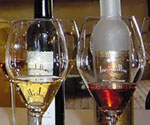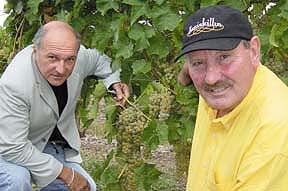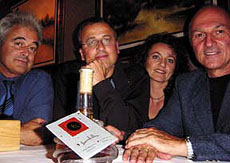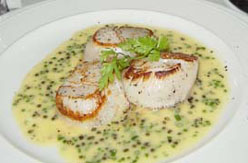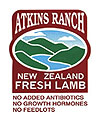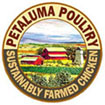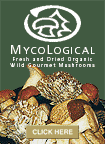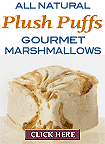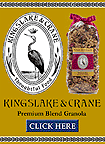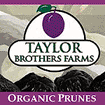By
Stephen Ashton
| |
| INNISKILLIN'S
DYNAMIC DUO DON ZIRALDO AND KARL KAISER, THE PIONEERS
OF CANADIAN ICEWINE WITH VIDAL GRAPES |
Niagara-On-The-Lake,
Ontario, Canada
When Austrian-born Karl Kaiser, homemade wine in hand, wandered
into Donald Ziraldo’s family-run nursery in 1971, neither
man imagined that they would become partners and more surprisingly,
world renowned visionaries largely responsible for creating
a wine industry and a new cool climate viticultural region.
Karl had been buying "French Hybrid" vines to make
wines similar to those he enjoyed back home in Austria. On
frequent visits to the nursery, Karl would suggest Donald
sell, instead of Hybrids, the prized European clones –
Vitis Vinifera – which were virtually unavailable in
Canada at the time. Like everyone else, Donald was told that
the sensitive Viniferas could not survive the harsh, cold
winters of the Niagara Peninsula. Having tended vines in Austria,
Karl knew this was a fallacy. Foremost, Ontario runs on the
same latitude as areas in France. Secondly, Ontario possessed
a terroir (geography, climate and soil) ideal for growing
European varieties that flourish in cool viticultural climates.
Donald was taken by the idea and against the advice of "experts"
decided to plant Vitis Viniferas on his family farm. By 1975,
the two renegade wine-lovers were granted the first winery
license in Ontario, Canada, since Prohibition, 1929, by General
George Kitching. Their first vintages "were actually
undrinkable," Ziraldo says. But through trial and error,
and a stroke of good luck primed by determination, the wines,
over time, began to be noticed. The real turning point, however,
came in the 1980’s after Karl, remembering the joys
of Austrian and German wines made from frozen grapes, returned
to Europe to discover the secrets of this nectar which, due
to weather, could only be made a few years out of each decade.
By 1989, Inniskillin was making Icewine from Niagara Peninsula
Vidal grapes. Donald optimistically entered the 1989 vintage
into the 1991 VinExpo International Wine Competition, the
most prestigious wine competition in the world, held in Bordeaux,
France. Although personally delighted with their succulent
product, Ziraldo and Kaiser were as amazed as the rest of
the wine world when Inniskillin was awarded the prestigious
Grand Prix d’Honneur! (Higher than a gold medal.) This
success opened the eyes of wine lovers and wine writers from
around the world, and put Canada on the wine world map. In
Canada the winery was bombarded with international media demands.
Inniskillin Wines, while already successful among wine lovers,
became a household name with their Icewine becoming a national
treasure.
Since 1991, Icewine has become a highly priced and treasured
mainstay of Inniskillin and other Canadian wineries. It is
sold in North American and around the world, such as in Japan
and China.
Icewine is said to have been discovered in Franconia, Germany
in 1794 when a snap freeze caused the growers to harvest grapes
off the vines while frozen solid. Pressing off these grapes
in the bitter cold caused the first juice released to be extraordinarily
sweet! The same methods, although a bit more refined, are
in effect today. While Germany and Austria still make fine
Eisweins, it is Ontario, Canada that has become the most awarded
region for Icewines and the world’s biggest producer.
It is vital that the frozen grapes are hand picked and pressed
in the cold of night so that the morning sun does not thaw
them. The process is carefully monitored, because the pressing
must stop before the sweet juice becomes diluted. Yields are
therefore only about 1/10th of what a normal harvest would
bring. A lengthy fermentation process follows, and even though
the wines can be as high in alcohol as most white wines, about
11%, they retain a substantial amount of natural sugars, about
160 grams/liter. However, the grape’s natural acidity
balances this sweetness to perfect harmony, so as not to leave
a cloying sensation on the palate. The wines are typically
golden and brilliant, with aromas of apricot, pears, lychee,
nutmeg and vanilla. Complex flavors of honey, mango, tropical
fruits and spices are characteristics that drive aficionados
back to them year after year. Heady and delicious as an aperitif,
Icewines partner well with foie gras, fresh fruit dishes,
desserts and some rich seafood dishes.
Vidal in the most common varietal for Icewine, but Riesling,
Cabernet Franc, Chenin Blanc, and other varietals make excellent
dessert wines, each with unique nuances.
Donald Ziraldo has championed the Niagara Peninsula region
as one of the chosen viticultural areas of the world and now
more than 40 wineries are producing Icewines.
Not ones to rest on laurels, Ziraldo and Kaiser pursue other
Vinifera varietal wines that also gain unexpected praise.
Niagara grown Chardonnay and Pinot Noir wines are making names
for themselves in national and international competitions,
as well.
Wineries in the area, such as John Howard’s Vineland
Estates, are planting tests of many different varietals in
the quest for finding the very best clones suited for particular
micro-climates within the appellations of the Niagara region.
The area is also a favored travel destination. World class
restaurants, like Mark Picone at Vineland Estates Winery,
are creating magnificent food/wine pairings.
Ziraldo, who travels more than half of the year, spreads the
word about fine Canadian wines. He pays special attention
to the food and wine experience at the finest restaurants
in the world. He is quick to recognize excellence, such as
the special presentation he made recently upon the occasion
of Toronto’s Opus Restaurant On Prince Arthur’s
recognition as one of the TOP FIVE best restaurants in North
America. (See "Toronto-Great Places, Great Chefs"
in this issue.)
Donald Ziraldo is acknowledged as evangelizing the Canadian
wine regions in the same way that Robert Mondavi brought the
world’s respect to Napa Valley. Ziraldo was appointed
in 1993 to the Order of Ontario and then in 1998 was awarded
the Order of Canada, the nations highest honour for lifetime
achievement.
Donald Ziraldo continues to lead the industry into the future.
He is the Founding Chairman of the Vintner’s Quality
Alliance (VQA), a body that regulates the industry for quality
standards. The VQA is similar to France’s Appellation
Control (AOC) and Italy’s DOC.
|
|
GRILLED
PORK WITH FOIE GRAS,
SALSIFY AND LEMON THYME CONFIT |
ONTARIO
MINISTER
OF TOURISM
CAM-RIGHT |
|
|
DON'S
FRIEND ANN, DON ZIRALDO OF INNISKILLIN IN OPUS WITH
SCULPTURE BOTTLE OF THEIR BEST ICEWINE. |
SEARED
SCALLOPS WITH THE CANADIAN STURGEON CAVIAR AND CHIVE
BEURRE BLANCE SAUCE-THAT IS A MOUTHWATERING DELIGHT
WITH INNIDSKILLIN'S MONTAGUE VINEYARD PINOT NOIR |
Food
and Beverage International Film and Travel Editor Stephen
Ashton is, photographer,writer,and winegrower of Ashton Vineyards
Pinot Noir and Syrah, and Founder/Director of the Wine Country
Film Festival.
To find out
more, please visit www.riedel.com
Order on line visit the e-boutique at www.inniskillin.com
